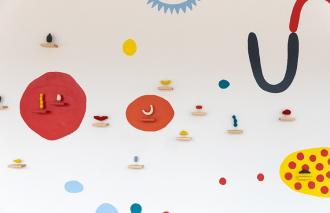At Berkeley Art Museum and Pacific Film Archive, Masako Miki’s MATRIX 273 fills the pristine white exhibition room with vibrant splashes of color and funky forms. Born in Osaka, Japan, Miki is currently a Bay Area artist whose sculptures, installations and murals have created an intriguing playground of art. Miki draws inspiration from Japanese folklore, and her mixed media pieces are also known for reflecting Shinto beliefs. Miki is not afraid to be experimental, and her art successfully pushes past the boundaries and limitations of a static frame.
The felt-covered sculptures scattered around the exhibit are inspired by a diverse pool of yokai, shapeshifters of Japanese folklore. These yokai inhabit a variety of forms, from a one-eyed goblin to a faceless ghost. A laminated card labeled “Shapeshifters in Playgrounds” serves as a guide for museumgoers to all of these unique characters.
In addition to these dynamic in-the-round sculptures, Miki has decorated the walls and floor of the exhibit space with murals that playfully interact with their three-dimensional counterparts. For instance, Ichiren-bozu (Animated Prayer Beads), a duo that resemble cheeto puffs, occupies a corner. A large blue bead dominates the limited space, and a small orange bead leans against the wall. The surrounding area is painted with orange dots of various sizes. Placing these felt forms against the backdrop of the paint-splattered wall blurs the line between dimensions. Without re-adjusting their view, the viewer would not be able to tell which shapes are voluptuous and which are flat. The format of the installation makes the viewer aware of their body and its relationship with the space around it.
Another instance of delightful juxtaposition and layering is found in Miki’s Noppera-bo (Faceless Ghost) sculpture, which hangs from the ceiling, coupled with a pair of eyes painted on the wall behind. From directly underneath the suspended sculpture, the ghost can be seen as a solitary entity. Against a particularly embellished side of the room, however, it becomes the nose of a face. The gently closed eyes are painted high up to accommodate the white structure that hangs exactly in the middle of the two lids. Pastel ovals that resemble an open mouth and perhaps blush marks complete the face on the lower half of the wall. Miki is clearly a master of getting creative with negative space. Her craft definitely creates an immersive and interactive experience for the viewer.
Miki may be attempting to include the viewer within her art. With the growing trend in pop-up art experiences and increasingly interactive museums such as the Museum of Ice Cream in San Francisco, different methods of art consumption are evolving. As an installation exhibit, MATRIX 273 is naturally supposed to be integrative and panoramic. Miki’s pastel colors, soft textures and adorably abstracted mushrooms scream, “Take pictures with me!” These days, museum visitors seem to have more fun when the art revolves around them, and this exhibit offers a lovely opportunity to be a part of a whimsical world.
There are many forms in this exhibit that visually do not resemble their name. Ungaikyo (Possessed Mirror) is particularly eye-catching. Shaped like a giant speckled jelly bean, the piece does not look like a mirror at all. Mirrors — if not ornate — are usually flat, so it is interesting that Miki decided to use such a bulbous form here. The sculpture actually looks like a piece of furniture, perhaps from Willy Wonka’s living room. The dip in the middle of the piece may evoke a sudden visceral urge in the beholder to sit on it. By encouraging the viewer to question their labels, shape and function, the fluid and versatile shapeshifters certainly succeed in dissolving boundaries.
Miki seems particularly interested in breaking down binaries and creating synthesis. Her culturally charged work effectively challenges the “absolute” principles of art, energy and space. Reconstructing the space around her, Miki reminds the viewers that the world is more connected than they think.
